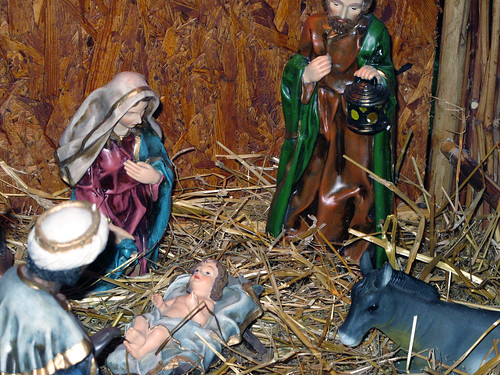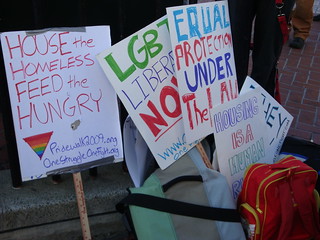 HEARD TELL, PERHAPS APOCRYPHAL, SOME YEARS AGO OF A SERMON given--if memory serves me--by our former bishop, the Rt. Rev. John Shelby Spong. His Grace began by drawing a Johari window-style diagram, with four unlabeled panes, on an easel pad and asked the congregants to rattle off things they knew about the Christmas story ("laid in a manger" "three wise men" "answering the census", etc.) which he proceeded to put in one of the boxes without comment.
HEARD TELL, PERHAPS APOCRYPHAL, SOME YEARS AGO OF A SERMON given--if memory serves me--by our former bishop, the Rt. Rev. John Shelby Spong. His Grace began by drawing a Johari window-style diagram, with four unlabeled panes, on an easel pad and asked the congregants to rattle off things they knew about the Christmas story ("laid in a manger" "three wise men" "answering the census", etc.) which he proceeded to put in one of the boxes without comment.When he was satisfied, he labeled the boxes "Matthew" "Luke" "John" and "Hallmark". Guess which one had the most in it?
The sermon was intended to educate us about what we know, vs. what we think we know about the birth of Christ. As I have embarked as an adult on a more informed understanding of my faith, I have discovered that much of the "givens" with which I had grown up are not scriptural in origin, and even the ones that are still find themselves subject to nuances of interpretation. For example, nowhere in Scripture does it say there were three wise men, but yet we "know" this and we even "know" their names.
Shine on, Surfer Jesus |
Even today when I search Youtube to hear some of the music that evokes that time for me, the videos (often lovingly if amateurishly produced by the faithful) show Jesus tall and chiseled, his grin perfect and his blond highlights catching the sun off the Galilee, looking for all the world like he might have just left his surfboard on the beach.
This does of course not fit with even the assumptions we can safely make in absence of facts. Icelandair did not serve Tel Aviv in the time these stories described, and nothing we've been able to find suggests Jesus worked as an Abercrombie & Fitch greeter prior to his public ministry. The Holy Family and Jesus' subsequent followers were in--all likelihood--short (by today's standards), olive-skinned, hairy, and frequently wont of a bath.
This was all brought to mind recently by a wonderful article by Joe Kay about holiday manger scenes, where he asks why these characters are all portrayed as serene and picture-perfect (and, inexplicably, Norwegian) despite what little we know about the journey they took, the conditions in which they lived, the money they didn't have? I won't try to paraphrase what Mr. Kay says, because frankly I can't improve upon it:
"If our manger scenes were realistic, Mary would be recovering from a painful labor full of sweat and blood, with a look on her face that’s anything but serene. And Joseph — wouldn’t he be a nervous wreck, too? His hand too shaky to hold a lantern?
And about that newborn. Shouldn’t he be red-faced and screaming? Eyes clenched closed and wisps of hair stuck to the top of a head that‘s still odd-shaped from all the squeezing?
Instead, we’ve sanitized and romanticized it. We’ve removed all the blood and sweat and tears and pain and goo. It’s no longer something real. We’ve left out all the messy parts. The oh-my-God-what-now parts. The I’m-screaming-as-loud-as-I-can-because-it-really-hurts parts. The oh-crap-I’ve-stepped-in-the-animal-droppings parts. The real parts."
 |
| Nativity scene at St. George's Church, Kobanya, Budapest, Hungary PHOTO CREDIT: András Fülöp Used under Creative Commons license. Some rights reserved |
Since we have artistic control of how we "see" them, why do choose to make them look perfect and unflustered when we know this was not the case? Why--as we struggle to make this more than a season of spending money we don’t have to buy people, some of whom we don’t even like, gifts they don’t need; eating and drinking too much and then feeling guilty--do we give the heroes of this story supernatural powers they didn’t have (endless energy, patience, WetNaps...) and make them less like us?
I think it is a shame that the canonical Gospels don't include the argument after Joseph refused to ask for directions and the donkey ended up circling Bethlehem for 45 minutes with his left signal on, or the talking-to Jesus got when the bus had to go all the way back to Jerusalem because he was still at the temple, wowing 'em with his mad parable skillz. We set ourselves up for disappointment when we fall for the notion that everybody else's Christmas looks like the families in TV ads, with nobody arguing or making hard choices about how to afford it all.
As for me and my house, we’d prefer a savior who chuckles and nods knowingly when we vacuum around the piles of clutter, or "phone in" the office potluck by putting something from the deli in our own Corningware. That is the God who may wince a little when we are short-tempered or selfish, but has been there and gets it. This is a time of year when many of us are faced, more than any other time, with the urge to curl up in a ball, mid-gift wrap or bike-assembly, and cry a little. That is a God I could call on in my darkest hour and expect to be understood, and Kay seems to agree:
"We acknowledge our brokenness, and God responds with a kiss on our sweaty faces and goo-covered foreheads. Reminds us that even though we make mistakes and bad choices, we ourselves are never a mistake or a bad choice. Instead, we are always a chosen miracle. And when we feel totally broken, that’s when we’re the most beloved."If your sugarplums are all color-coordinated and your family beach photo with the Santa hats came out perfectly on the first try, more power to you. Go ahead and carve your nativity figures out of cream cheese just like Martha taught you. We, the Chaos Muppets, may need to tape a sheep's leg back on or bring in the Power Ranger understudy for one of the shepherds, but each will nonetheless be a familiar home to the Savior when he comes.
May God bless us, every one.
















